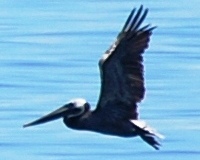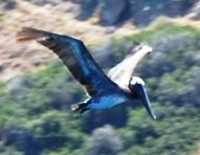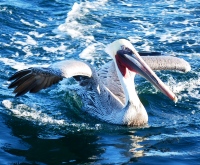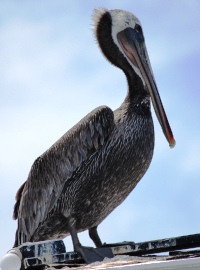(949) 675-0551 |
 |
DESCRIPTION: Brown pelicans weigh about 8 pounds and measure up to 4 feet in length, with a wingspan of about 6 feet. Sexes look similar, though males are slightly larger. Brown pelicans have short, dark legs, long, broad wings, a large, heavy all-brown body, and a huge bill. Webbing between all four toes makes the brown pelican an awkward walker, but a strong swimmer. In basic plumage, juvenile Brown Pelicans have a brown body with a cream white belly and neck. They have brown eyes, a tan bill that is tipped with yellow, and a tan throat pouch. Adults have a white neck and belly, pale white/yellow head, a brown body, brown eyes, a throat pouch that is reddish orange, and a bill that is paler at the base and tipped with yellow. As the breeding season approaches, the end of the bill and the throat pouch become reddish in color. The iris of their eye turns a yellowish white to light blue. |
 |
RANGE/HABITAT: The California brown pelican is a permanent resident of the coastal marine environment on the Pacific Coast and the range extends from north Canada to south Mexico. The majority of the California Brown Pelican population is believed to nests in Mexico. The only long-term breeding colonies of California Brown Pelicans in the United States are on costal islands. These islands provide protected roosting habitats for the birds. The major roosting areas occur on offshore rocks of Santa Cruz Island, near the lighthouse on East Anacapa Island, costal rocks off of Santa Barbara Island, Santa Rosa Island, Santa Catalina Island, and San Clemente Island. |
 |
BEHAVIOR: The California brown pelican stays close to shore and hunts for its food usually within five miles of land. The brown pelican hunts its prey by diving from up to thirty above the surface. When it sees a potential meal it begins to tip downwards, the wings shape into a "V", and dives. When the bill touches the surface of the water the pelican will push its legs and wings back creating a bit more force. Once under the water the bill opens and the pouch stretches out allowing the pelican to scoop up its prey. The pelicans hit the water with such force that their prey becomes stunned and confused, which makes for easier capture. Their pouch when full can hold up to three gallons of water and fish. This is the distinguishing feature of the pelican. The pelican pops up to the surface, tips their bill forward draining out the water while retaining the fish. Then they toss their head about to position the fish to be swallowed head first. Brown pelicans can consume up to four pounds of fish per day. |
 |
MATING/BREEDING: The nesting season historically began in March and extended through late summer or early fall, but in recent years has often surpassed 11 months. Brown Pelicans typically lay two to three eggs. The peak egg laying period is usually March or April. Incubation commences after the first egg is laid, and males and females share incubation duties. Breeding success is determined by the availability of their primary food items such as anchovies and sardines. During the breeding season these two types of fish make up nearly their whole diet. Abandonment of nests may occur if food availability is low in the nesting areas. Brown pelican chicks are helpless and completely depend on parental care and protection for the first three to four weeks after hatching. Both parents assume feeding responsibilities. In California populations, chicks typically are strong enough to leave the nest at about 13 weeks of age. A high percentage of the young pelicans die due to unsuccessful and inexperienced attempts at finding food. STATUS: The federal government listed the Brown Pelican as an endangered species in 1970, the state of California listed it as endangered in 1971. The fight to save these birds led to a remarkable recovery. Breeding populations have steadily increased since 1980, and in 2009, the brown pelican was removed from the Federal List of Endangered and Threatened Wildlife due to recovery. This action was based on a review of the best available scientific and commercial data, which indicated that the species is no longer in danger of extinction, or likely to become so within the foreseeable future. The brown pelican remains protected under the Migratory Bird Treaty Act. |
For Reservations Call: |
||
(949) 675-0551 |
||
Newport Beach Whale Watching 309 Palm St. #A - Newport Beach CA. 92661 |
||
Copyright © 2001 Newport Landing
Whale Watching |
Whale Watching | Whale Watching Dana Point Visitors | Whale Watching Long Beach Visitors | Whale Watching Los Angeles Visitors
Whale Watching San Diego Visitors | Huntington Beach Whale Watching | Whale Watching Laguna Beach | Catalina Island Whale Watching